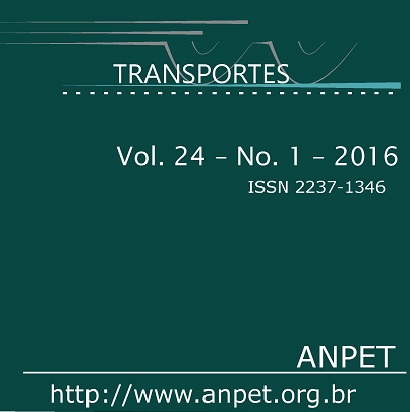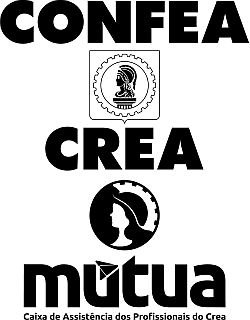Proposição e análise de um sistema de gerenciamento ativo de tráfego em um estudo de caso de uma autoestrada
DOI:
https://doi.org/10.14295/transportes.v24i1.925Palavras-chave:
Gerenciamento ativo de tráfego, Harmonização da velocidade, Uso temporário do acostamento, Vissim.Resumo
O objetivo principal deste artigo é implementar e testar estratégias de gerenciamento ativo de tráfego em um trecho de uma autoestrada brasileira, a fim de avaliar e quantificar a eficácia destas estratégias. O gerenciamento ativo de tráfego é um sistema que gerencia dinamicamente o fluxo com base nas condições de tráfego existentes. O software de microssimulação de tráfego usado para modelagem foi o VISSIM, e foi calibrado para representar as particularidades do comportamento dos motoristas na autoestrada em estudo. As estratégias empregadas na simulação foram a de harmonização da velocidade e a do uso temporário do acostamento. O estudo demonstrou que o gerenciamento ativo de tráfego tem impactos positivos na operação do tráfego e os benefícios mensurados na simulação incluem: redução de headways, redução nos tempos médios de viagem e na variação dos tempos de viagem, e redução no número de trocas de faixa. O uso das estratégias também trouxe redução do tempo de congestionamento, aumentando a eficiência do trecho.
Downloads
Referências
Allaby, P., Hellinga, B., e Bullock, M. (2007). Variable speed limits: safety and Operational Impacts of a Candidate Control Strategy for Freeway Applications. IEEE Transactions on Intelligent Transportation Systems, 8(4), 671–680. DOI: 10.1109/TITS.2007.908562
Caleffi, F., Y. Moisan, H. B. B. Cybis, F. D. Michel e F. Hirsh (2012). Simulação de alternativas operacionais de um segmento especial de autoestrada através do software VISSIM. CONGRESSO DE PESQUISA E ENSINO EM TRANSPORTES,26,.2012. Anais... Belo Horizonte: ANPET, v. 1, p. 36-47.
Carlson, R. C., Papamichail, I., Papageorgiou, M., e Messmer, A. (2010). Optimal motorway traffic flow control involving variable speed limits and ramp metering. Transportation Science, 44(2), 238–253. DOI: 10.1287/trsc.1090.0314
Mirshahi, M., Obenberger, J., Fuhs, C. A., Howard, C. E., Krammes, R. A., Kuhn, B. T., Mayhew, R. M., Moore, M. A., Sahebjam, K., Stone, C. J., e Yung, J. L. (2007). Active traffic management: the next step in congestion management. Federal Highway Administration, Report no. fhwa-pl-07-012, Washington D.C.
Jeffrey C. Jones, Knopp, M. C., Fitzpatrick, K., Doctor, M. A., Howard, C. E., Laragan, G. M., Rosenow, J. A., Struve, B. A., Thrasher, B. A., e Young, E. G. (2011). Freeway geometric design for active traffic management in Europe. Federal Highway Administration, Report No. FHWA-PL-11-004, Washington D.C.
Fontaine, M. D. e J. S. Miller (2012). Planning for active traffic management in virginia: International Best Practices and Implementation Strategies. Virginia Center for Transportation Inovation and reaserch, Final Report VCTIR 13-R1, USA.
Geistefeldt, J. (2013) Impact of Variable Speed Limits on Motorway Level of Service. International Journal of Intelligent Transportation Systems Research, 12(2), 61–69. DOI: 10.1007/s13177-013-0072-x
Gettman, D., e Head, L. (2003). Surrogate safety measures from traffic simulation models. Transportation Research Record: Journal of the Transportation Research Board, 1840(1), 104–115. DOI: 10.3141/1840-12
Nezamuddin, N., N. Jiang, T. Zhang, S. T. Waller e D. Sun (2011). Traffic operations and safety benefits of active traffic strategies on TxDOT Freeways. Federal Highways Administration, Publication Number: FHWA/TX-12/0-6576-1, USA.
Papageorgiou, M., Kosmatopoulos, E., e Papamichail, I. (2008). Effects of variable speed limits on motorway traffic flow. Transportation Research Record: Journal of the Transportation Research Board, 2047(-1), 37–48. DOI: 10.3141/2047-05
Park, B. B., e Qi, H. M. (2006) Microscopic simulation model calibration and validation for freeway work zone network - a case study of VISSIM. 2006. IEEE Intelligent Transportation Systems Conference, 1471–1476. DOI: 10.1109/ITSC.2006.1707431
PTV (2010) Vissim user manual: v.5.30. Karlsruhe, Alemanha.
Sisiopiku, V. P., Sullivan, A., e Fadel, G. (2009). Implementing active traffic management strategies in the U.S. University transportation center for Alabama, Department of Management and Safety in Transportation Systems.Report no. 08206, USA.
Vadde, R.; D. Sun, J. O. Sai, M. A. Faruqi e P. T. Leelani (2012). A simulation study of using active traffic management stategies on congested freeways. Journal of Modern Transportation, v. 20, n. 3, p. 178-184. DOI: 10.1007/BF03325796
Downloads
Publicado
Como Citar
Edição
Seção
Licença
Ao submeter um manuscrito para publicação neste periódico, todos os seus autores concordam, antecipada e irrestritamente, com os seguintes termos:
- Os autores mantém os direitos autorais e concedem à Transportes o direito de primeira publicação do manuscrito, sem nenhum ônus financeiro, e abrem mão de qualquer outra remuneração pela sua publicação pela ANPET.
- Ao ser publicado pela Transportes, o manuscrito fica automaticamente licenciado sob a Licença Creative Commons CC BY 4.0. Esta licença permite o seu compartilhamento com reconhecimento da autoria e da publicação inicial neste periódico.
- Os autores têm autorização para assumir contratos adicionais separadamente, para distribuição não exclusiva da versão do trabalho publicada neste periódico (por ex.: publicar em repositório institucional ou como capítulo de livro), com reconhecimento da publicação inicial na Transportes, desde que tal contrato não implique num endosso do conteúdo do manuscrito ou do novo veículo pela ANPET.
- Os autores têm permissão e são estimulados a publicar e distribuir seu manuscrito online (por ex.: em repositórios institucionais ou na sua página pessoal) depois de concluído o processo editorial. Como a Transportes é de acesso livre, os autores são estimulados a usar links para o DOI do artigo nesses casos.
- Os autores garantem que obtiveram todas as permissões necessárias dos empregadores para a publicação e o licenciamento CC BY 4.0 do manuscrito, especialmente se o empregador possuir alguma reivindicação sobre os direitos autorais do manuscrito. Os autores assumem total responsabilidade por questões de direitos autorais relacionadas ao empregador, isentando a ANPET e a Transportes de qualquer responsabilidade relacionada.
- Os autores assumem toda responsabilidade sobre o conteúdo do manuscrito, incluindo as devidas e necessárias autorizações para divulgação de dados coletados e resultados obtidos, isentando a ANPET e a Transportes de toda e qualquer responsabilidade neste sentido.
Última atualização: 27/11/2025











